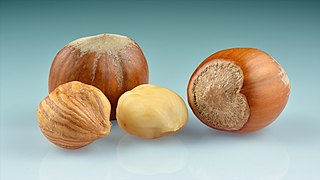
Rusts are fungal plant pathogens of the order Pucciniales causing plant fungal diseases.

The hazelnut is the fruit of the hazel tree and therefore includes any of the nuts deriving from species of the genus Corylus, especially the nuts of the species Corylus avellana. They are also known as cobnuts or filberts according to species.

Hazels are plants of the genus Corylus of deciduous trees and large shrubs native to the temperate Northern Hemisphere. The genus is usually placed in the birch family Betulaceae, though some botanists split the hazels into a separate family Corylaceae. The fruit of the hazel is the hazelnut.

Corylus avellana, the common hazel, is a species of flowering plant in the birch family Betulaceae, native to Europe and Western Asia. It is an important component of the hedgerows that were, historically, used as property and field boundaries in lowland England. The wood was traditionally grown as coppice, with the poles cut being used for wattle-and-daub building, and agricultural fencing.

Corylus maxima, the filbert, is a species of hazel in the birch family Betulaceae, native to southeastern Europe and southwestern Asia, from the Balkans to Ordu in Turkey.

A catkin or ament is a slim, cylindrical flower cluster, with inconspicuous or no petals, usually wind-pollinated (anemophilous) but sometimes insect-pollinated. They contain many, usually unisexual flowers, arranged closely along a central stem that is often drooping. They are found in many plant families, including Betulaceae, Fagaceae, Moraceae, and Salicaceae.

Corylus cornuta, the beaked hazelnut, is a deciduous shrubby hazel with two subspecies found throughout most of North America.

Microsphaera penicillata is a plant pathogen that causes powdery mildew on sycamore.

Puccinia is a genus of fungi. All species in this genus are obligate plant pathogens and are known as rusts. The genus contains about 4000 species.

Corylus americana, the American hazelnut or American hazel, is a species of deciduous shrub in the genus Corylus, native to the eastern and central United States and extreme southern parts of eastern and central Canada.
Corylus colchica, also known as Corylus iberica, is a species of hazelnut endemic to Armenia and Georgia in the Caucasus region. It can tolerate more frost than many others of its genus. It produces small edible nuts in September. It is not commercially grown for food because the nuts are small in size. The nut's shell is oval and the nut is round. The tree is sometimes crossed with the common hazel to make a hybrid that can grow in colder climates.

Notodonta dromedarius, the iron prominent, is a moth of the family Notodontidae. The species was first described by Carl Linnaeus in 1767. It is found in Europe and Anatolia.

Stigmella floslactella is a moth of the family Nepticulidae. It is found in all of Europe, except the Balkan Peninsula and the Mediterranean islands.

Phyllonorycter coryli, or nut leaf blister moth, is a moth of the family Gracillariidae. It is found most of Europe, except the Balkan Peninsula.

Rust is a multi-paradigm, general-purpose programming language that emphasizes performance, type safety, and concurrency. It enforces memory safety, meaning that all references point to valid memory, without requiring the use of automated memory management techniques, such as garbage collection. To simultaneously enforce memory safety and prevent data races, its "borrow checker" tracks the object lifetime of all references in a program during compilation. Rust was influenced by ideas from functional programming, including immutability, higher-order functions, and algebraic data types. It is popular for systems programming.

Parornix devoniella is a moth of the family Gracillariidae. It is known from all of Europe.
Phyllonorycter japonica is a moth of the family Gracillariidae. It is known from Japan and the Russian Far East.

Cameraria corylisella is a moth of the family Gracillariidae. It is known from Manitoba, Ontario, and Quebec in Canada, and Kentucky, Wisconsin, Maine, New York, Connecticut and Vermont in the United States.
Acrobasis normella is a species of snout moth in the genus Acrobasis. It was described by Harrison Gray Dyar Jr. in 1908, and is known from Ontario, Canada, and central and eastern United States.

Argyresthia ivella is a moth of the family Yponomeutidae. It is found in most of Europe, except Ireland, the Netherlands, the Iberian Peninsula, Finland, Italy, Slovakia and most of the Balkan Peninsula.














